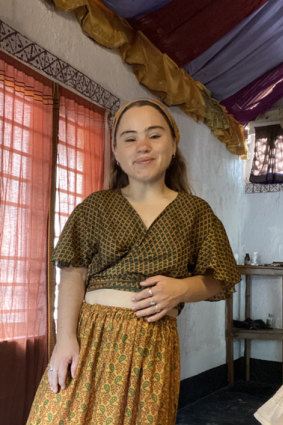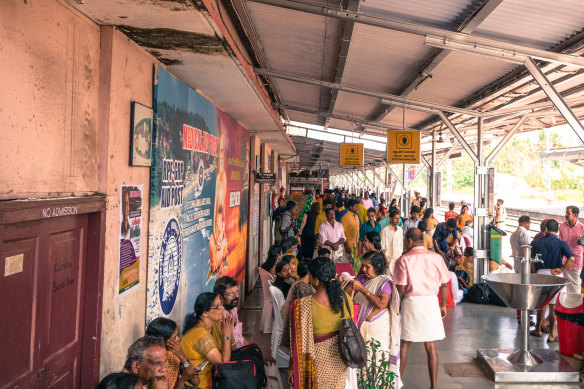This was published 1 year ago
Opinion
I went overseas solo for the first time since becoming disabled. Here’s how it went
Imogen Kars
Travel writerIt was just like any other solo trip I had taken before. My carry-on backpack was bursting at the seams (a ruthless middle finger to airline baggage limits) and my insatiable itch to just go was akin to a polar bear’s first meal after hibernation. Impatient and ready.

Imogen Kars in India.
The pre-travel to-do list was ticked off and tucked away. Everything was ready to roll. But as I boarded the plane headed for India, the gravity of travelling without my partner hit me.
I wasn’t afraid to be alone in India (I’d visited twice before). I wasn’t mourning the solo trip without an adventure buddy to exchange cheesy grins or side-eye glances with. I was, however, utterly terrified of the thought of getting locked in a bathroom. Of fumbling with a train ticket. Of lugging drinking water back to a guest house. Funny little worries for a world traveller. But when you travel solo with a disability, the fear takes up more space than I’d sometimes care to admit.
Prior to the pandemic, I developed multiple disabilities – most of them affecting my hand dexterity. In layman’s terms, this means I often struggle with actions like making food, using door knobs, texting on the phone, hanging the washing out and brushing my hair. Take these experiences to the depths of India, and you may be able to imagine how it opens up a whole new can of worms.
So why continue to travel solo now that things have become harder? Because despite the diagnoses, the swollen digits, the raging fatigue that hits me in full swing when I least expect it, I’m a human being who wants to see the world (even if I can’t see out of my right eye). I’ve travelled prolifically through my 20s: hunkering down on the Red Sea, taking up a hash diet in a local holiday hotspot in Morocco, running a bootleg cafe with my partner in Goa, and no matter what it looks like, I’ll do it again. And again. And again.
But that doesn’t mean it isn’t hard. Or that it doesn’t scare me to the bone. It just means I have to get a little creative.
I landed in Kerala at 4am, breathing in the sweet, sticky tropical humidity of my favourite Indian state. I collapsed into the hotel bed and woke a few hours later to find the door half-open. In between my daze and my shoddy hands, I hadn’t latched the door properly. Oh, what a bold welcome to my world for the next few weeks. I had a feeling I was about to see a whole new side of India, one that wasn’t designed for folk like me (despite there being an estimated 90 million Indians living with disability).
That morning, reality hit me like a tonne of bricks. The shower tap was too tough for me to wrangle. The shower head was too high. I got dressed again and waddled down to reception to ask the hotel manager for help.
He smiled, nodded and swiftly led me back up the stairs. His reaction felt like a blessing. In an instant, I felt cradled by this magnificent country. India evokes a sensory overload, but wherever you look, you’ll find a warm smile and a helping hand.
The next few days were an ebb and flow of the two extremes. Every experience was a rollercoaster of emotions. I ventured out to take a train from Thrivandrum to Varkala, my heavy backpack towering over my tiny 140-centimetre body. The trip was only half an hour long, but, like anyone who has taken a train in India might know, confusion in an Indian train station is a rite of passage.

Navigating an Indian train station is a rite of passage for travellers.Credit: iStock
From translating the ticket, to navigating the station, the points and nods studding the broken conversations with Malayalam-speaking porters are the only saving grace. And with sweat dripping into my good eye, my vision leering out of focus from stress, and my hands seizing up thanks to the high humidity, it was a kind of chaos that rocked me to my core.
But the exhale arrived, as it always did, thanks to a group of sari-adorned Keralan women. They held my arm, accompanied me to my platform and bought me a samosa for my troubles.
It’s always moments like these that feel out-of-this-world for me on my travels. The Taj Mahal or the Pyramids of Giza certainly fill me up with a sense of wonder. But it never spills over like it does when I spend a four-hour train ride sitting beside an old man who buys me chai (all the while arming me with gentle life advice and Bluetooth-ing me his favourite sunset pictures from the port).
The rest of my month-long trip was dotted with moments where I felt stuck. But it dawned on me that this stuckness brings something special into my orbit. A sense of connection and community. Of camaraderie that I wouldn’t get to experience with well-oiled hands and an able body.
On the final night, on my way to Kochi airport, the taxi driver signalled his favourite chai wallah was coming up on the right. He bought me a deep-fried banana and my final chai, and when we plopped back into the sweaty sedan, he asked me what I had learned from India this time around.
I couldn’t help but well up with tears. I was sunburnt, exhausted and slender from a rice and dahl diet. Over that past month, I had experienced some of my most shameful and painful experiences since living with disability.
But it felt real. And exciting. I’d realised my powers, and not despite my disabilities. Because of my disabilities. And for me, that will always be worth fumbling with door handles in foreign countries.
Sign up for the Traveller newsletter
The latest travel news, tips and inspiration delivered to your inbox. Sign up now.